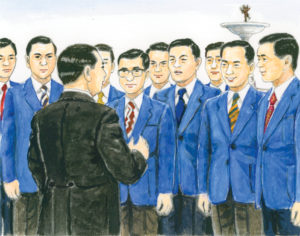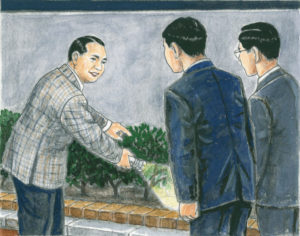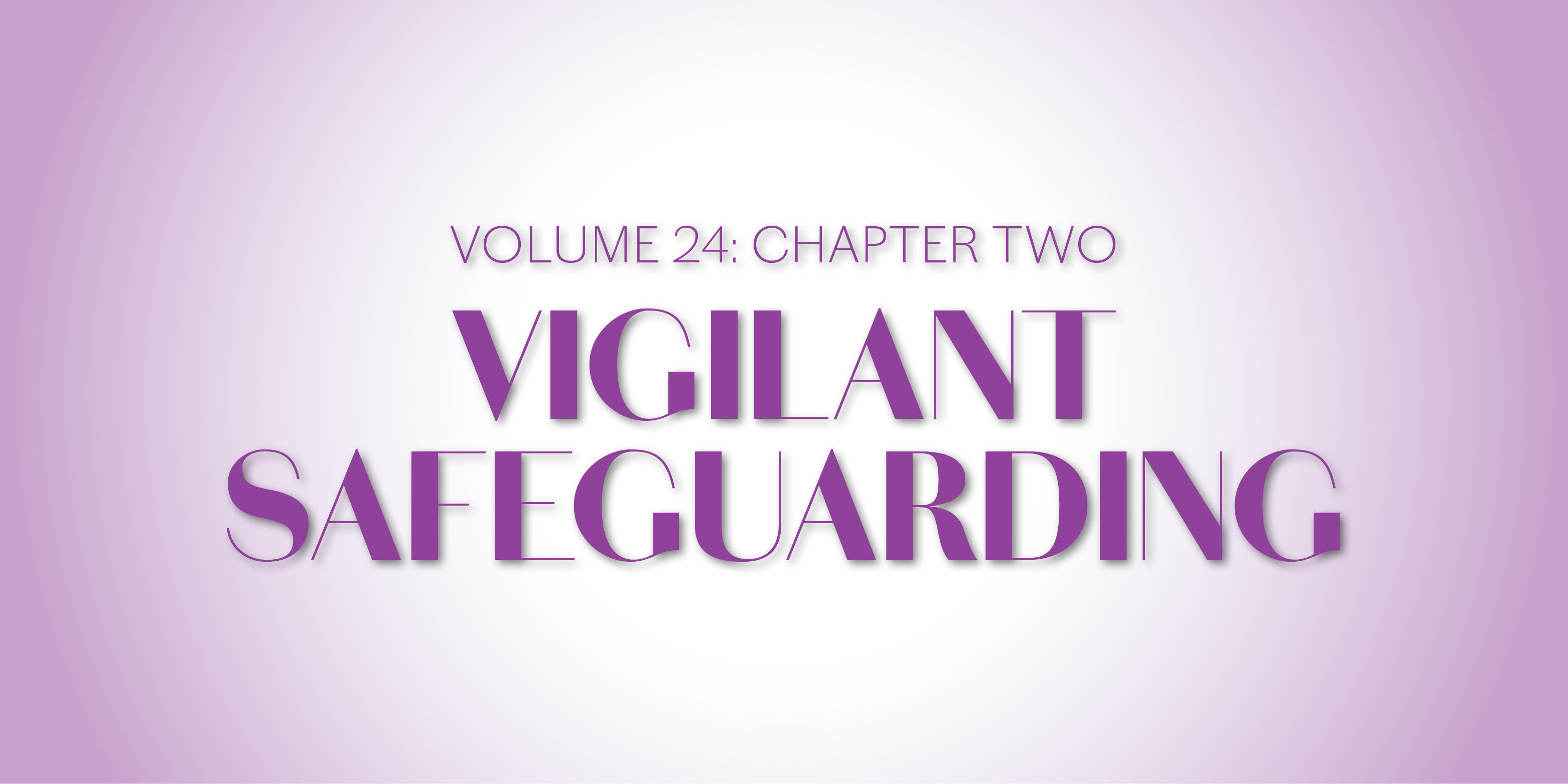Chapter Summary

Illustration courtesy of Seikyo Press.
One night in late autumn of 1976, Shin’ichi set out with members of the Gajokai to thoroughly inspect the Soka Gakkai headquarters facilities and surrounding areas in order to ensure against any fi res and mishaps. He emphasized with the young men the importance to have the spirit to protect the Soka Gakkai.
With respect to the Soka Group, Shin’ichi proposed that a general meeting be held on January 6, 1977. In November 1976, the Traffic Control Group was disbanded and simultaneously reconstituted as the Soka Group. This was a fresh departure for this training group tasked with supporting the operations of various activities and events.
After the New Year’s Meeting on January 1, 1977, Shin’ichi took commemorative photos with on-duty members of the Soka Group in the Soka Gakkai Headquarters courtyard. Referring to the lyrics of the “Song of Human Revolution,” he emphasized the words “pressing on through blizzards, we boldly advance,” urging the youth to advance with that spirit.
Shin’ichi also joined several commemorative photo sessions with members of the Byakuren, the young women’s behind-the-scenes training group.
Through establishing various training groups, he hoped to foster youth who could protect and support the members. He also assured them that, although their sincere efforts may seem to go unnoticed by others, they should know that Buddhas and bodhisattvas throughout the universe are aware of their actions, based on the causality of life (see The New Human Revolution, vol. 24, pp. 121–22).
The year 1977 was designated as the Soka Gakkai’s Year of Study. The New Year’s Day issue of the Seikyo Shimbun carried Shin’ichi’s lecture on Nichiren’s writing “The True Aspect of All Phenomena.” Also, installments of his lecture series on “Hyaku rokka sho” (The One Hundred and Six Comparisons)[1] also began from the January issue of the Daibyakurenge, the Soka Gakkai’s monthly study journal.
At a Soka Gakkai Study Department meeting in Osaka on January 15, Shin’ichi stated clearly that Shakyamuni sought to restore religion to the people. “Making this significant transformation from exploiting people for the sake of religion to restoring religion to its proper role of existing for the sake of the people was the starting point of Buddhism,” he said (NHR- 24, 158).
Thus, Shin’ichi raised the banner of study to open the way to a new era of kosen-rufu.
Unforgettable Scene

Illustration courtesy of Seikyo Press.
Thoroughly Reviewing the Basics Prevents Accidents
One evening in the late autumn of 1976, Shin’ichi Yamamoto carried out detailed inspections inside and around the Soka Gakkai Headquarters with two members of the Gajokai, a young men’s behind-the-scenes training group.
Shin’ichi carried out a detailed inspection, including making sure that the stove burners in kitchen facilities, and the lights and electrical appliances in rooms not in use were all shut off. Outside, he directed the light of a flashlight toward the base of the plants and flowers in front of the buildings to make sure no dangerous materials had been placed there. …
“Eyes that notice the littlest things can prevent the biggest accidents.
“To prevent accidents, everyone should consider the matter carefully, decide on a basic roster of things that need to be checked, and then follow it assiduously. …
“Once a routine is set, it needs to be carried out faithfully, without skipping or ignoring any part of it. If you allow it to become a mere formality and lose your focus, carelessness will follow. That’s the most dangerous thing.” …
As he continued to inspect the buildings in the area around the headquarters, Shin’ichi said: “This period from now to the end of the year is a time when there are not only many fires but also crimes, such as fraud or theft. Still, some tend to think that these kinds of things only happen to other people, never suspecting that they might become victims themselves. In fact, that’s the first sign of carelessness, and that way of thinking makes you vulnerable.
“Though we remind members at meetings to be careful not to have traffic accidents, there are plenty of cases when people say to themselves, ‘I know that,’ and don’t really pay attention. What you should do at that time is remind yourselves to be extra careful, and say the same to those around you. …
Shin’ichi walked with the two Gajokai members through the Seikyo Shimbun Building back to his home, which was nearby. His wife, Mineko, was at the entryway to greet him. She politely thanked the Gajokai members. As they parted Shin’ichi said to them: “Thank you for accompanying me today. Please aim for complete safety and security. I’ll also wholeheartedly pray for the same thing every day.
“I can’t go along with you on your rounds each time, but in my heart I’m always with you. We share the same mission. Please protect our headquarters in my stead. Protect our culture and community centers. Protect our members. Let’s meet again.”
That evening Shin’ichi and Mineko chanted Nam-myoho-renge-kyo intently for the Gajokai members to not catch a cold and to vigorously carry out their respective missions, and fulfill their greatest potential. (NHR-24, 87–89)
Key Passage
Understanding something in theory doesn’t necessarily mean one will actually be able to do it. During a disaster or accident, often people know what they should do but are unable to act. Hands-on training, repeated until fully mastered, best prepares one for action in a crisis. Training instills the lesson in one’s body and in one’s life. (NHR-24, 132)
References
- “Hyaku rokka sho” (The One Hundred and Six Comparisons) is not included in The Writings of Nichiren Daishonin, vols. 1 and 2. ↩︎
You are reading {{ meterCount }} of {{ meterMax }} free premium articles

